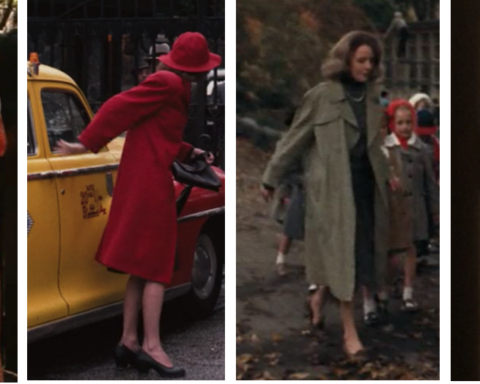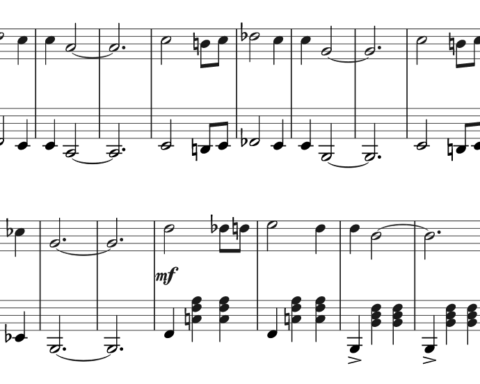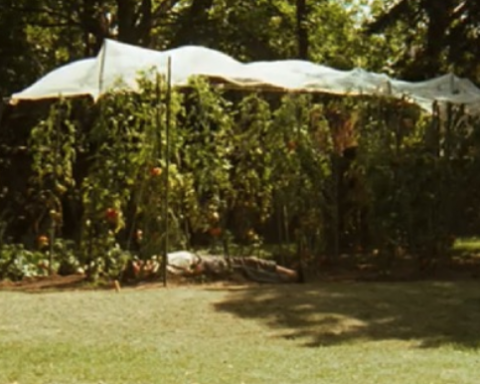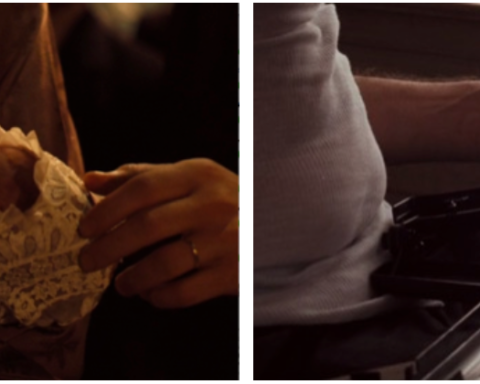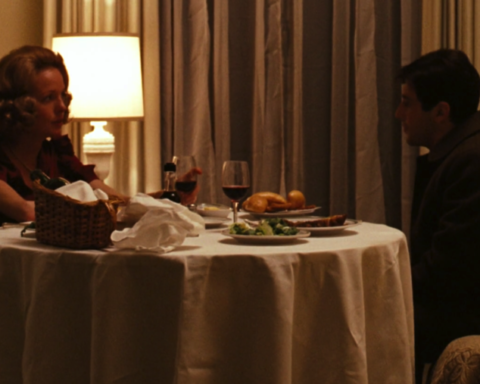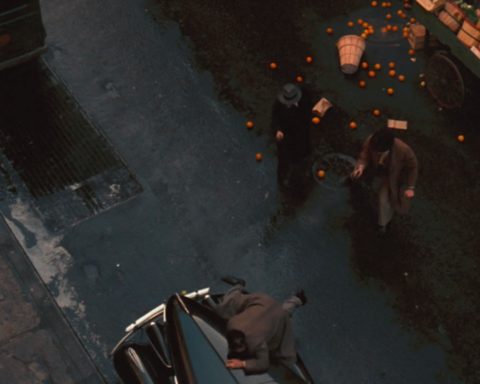The Corleone office is a crucial setting in The Godfather: after all, it is the place where Vito Corleone is introduced and subsequently the setting in which he hands over power to his son Michael. The office’s interior décor — first with Vito in power, and later with Michael — contains details that, while small to the audience’s eye, speak powerfully to how the mafia leaders choose to represent the family and how they manage the family’s affairs. Despite the office’s various changes as power shifts from father to son, enough of the décor stays the same to suggest that both men rely on a complicated moral framework — one that gives power to themselves and demands obedience from those around them. More radically, the office’s décor suggests a code of ethics which lacks depth — a framework more concerned with appearances than with discriminating between right and wrong.
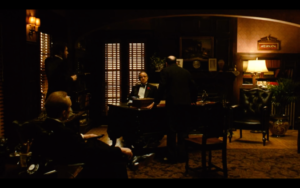
The first thing that stands out about Vito Corleone’s office is the lighting, or lack thereof. The blinds are only slightly open, and shadows draw the eye to the corner of the room: domestic wallpaper, portraits of family members on the mantel, along with a bookshelf create the impression that this meeting is taking place not in an office complex, but rather in the Corleone home — or, more precisely, in Vito’s study. The room’s overall darkness conveys that Vito handles the family business as a true criminal would: colluding in the shadows rather than being open about his affairs.
Fittingly, in the film’s opening scene, Bonasera has come to Vito’s office to ask for the favor of murdering the two men who attempted to rape his daughter. Vito, however, rejects Bonasera’s request, as Bonasera’s daughter is still alive and according to Vito “[the two men are] not murderers.” Vito’s dialogue, supported by the scene’s interior décor, furthers the notion that Vito is a just family man who is sympathetic to his fellow Italian Americans. However, this family man persona is as artificial as the office itself: doing business in the cozy confines of his office ensures that the violent acts carried out in his name cannot be traced, and so are not seen as a reflection of Vito’s character. Just as shadows mask images for what they truly are, so is Vito’s complicated morality masked by the appearances of his family business.
Likewise, the furniture in Vito’s office shows how he chooses to close off the outside world to his business. Three dark-colored chairs surround Vito’s desk, countered only by Vito’s light-colored leather chair. All of these chairs are padded except the chair directly across from Vito, which is reserved for those who require help from him. This layout is essential to how Vito conducts his business: the singular chair that sits across from him showcases that there is only room for one request at a time. Moreover, the lack of padding on this chair has symbolic resonances too: asking for Vito’s help is an uncomfortable experience, one that leaves you indebted to a powerful man — a man whose family business includes political bribery, extortion, and murder. From the perspective of protecting Vito’s familial image, the uncomfortable chair also ensures that no illegal request lasts longer than it needs to, and is over as quickly as possible. Vito may rebuke Bonasera for never inviting Vito to his house and for being terrified of being in his debt even though Vito’s wife is Godmother to his daughter—but the scene of the office suggests exactly why Bonasera would not have put himself in this literally uncomfortable position. Vito may offer himself as a family man helping out extended family and friends, but we see him also as a criminal who forces people into submissive positions to further his grip on power.

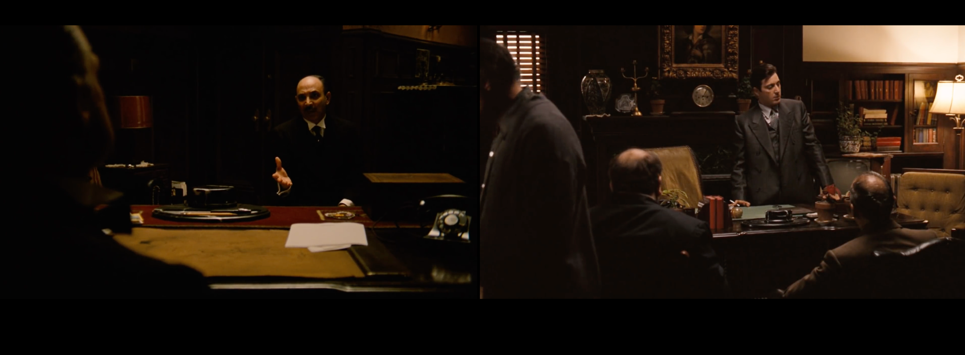
When Michael takes the reins of the family business and engages in some ‘office redecoration,’ we get a strong sense that there will be a power shift in how the family will operate. Where Vito’s office lacked light, Michael’s is exquisitely lit. The blinds in Michael’s office ushers in light unlike the previous blinds of Vito’s office, giving a sense that Michael is trying to push the family business into the legitimate corporate world of America. There will be no more hiding in the dark, no more whispering about back door deals and crimes: the family, at least in Michael’s eyes, is headed toward becoming completely ‘legit’ through the casino business in Las Vegas. The old wallpaper from before has now been replaced with white paint: Michael is proposing a fresh start for the family, with the family business becoming a proper one, with no illegal activity. Michael even tells Clemenza and Tessio that they can leave the Corleone family and start their organized crime ring only after the casino business is legitimate.
However, like his father, Michael never really abandons his family’s violent nature. This ‘fresh start’ — like the fresh paint of his office’s walls — is only doing what paint does, covering something in a thin layer to mask it. It is, quite literally, a “whitewash”. Michael’s morals are still aligned with the old wallpaper and the ways that his father had established for the family. A morality of family profits first and moral righteousness last. After all, Michael will not allow Clemenza and Tessio power until the Corleone family has established itself as a powerhouse in Las Vegas. Although Michael puts a new face on the family, he carries forward the family’s unwillingness to relinquish power and control of those around them.
The abundance of furniture in Michael’s new office speaks similarly to the modern spirit of inclusion and comfort that he is projecting. Two padded chairs now sit in front of Michael’s desk, whereas Vito only allowed for a single chair to sit directly across from him. The aesthetic of Michael’s office is that of a modern businessman: he has added carpet, chairs, and couches, all of which rest now in a circular formation. He seems to be creating a comfortable and inclusive environment: it’s no longer one person sitting in a single chair, as in Vito’s office, but multiple people sitting together at a conference meeting. The room is not anywhere near as threatening as Vito’s office at first glance.
At the same time, the new clutter on Michael’s desk suggests how complicated things are about to get under his command. The addition of two plants on his desk, as well as two more plants on the television and mantel, creates a sense that the office no longer is used to plan hit jobs but rather is now a place where life can thrive. However, the placement of books on Michael’s desk brings into question how much life will thrive in this space. The books suggest Michael’s more intellectual airs (in the novel he’s a Dartmouth grad); his actions aim to be more considered and planned. There also appears to be a ledger on the desk — suggesting that Michael will be engaging in a more formal system of “accounting,” in his business practices and in his settling of accounts with those who have betrayed the family. At the same time, the presence of all those books suggest another power play at work in Michael’s office. They may be part of his “mental game” — his way of convincing those who sit across from him that there’s a deeper level to Michael, morally and intellectually. Yet even though Vito has an empty desk, we should note that more violence comes from Michael than any other character within the movie. He masks his moral wrongs like he masks his office with new furniture.
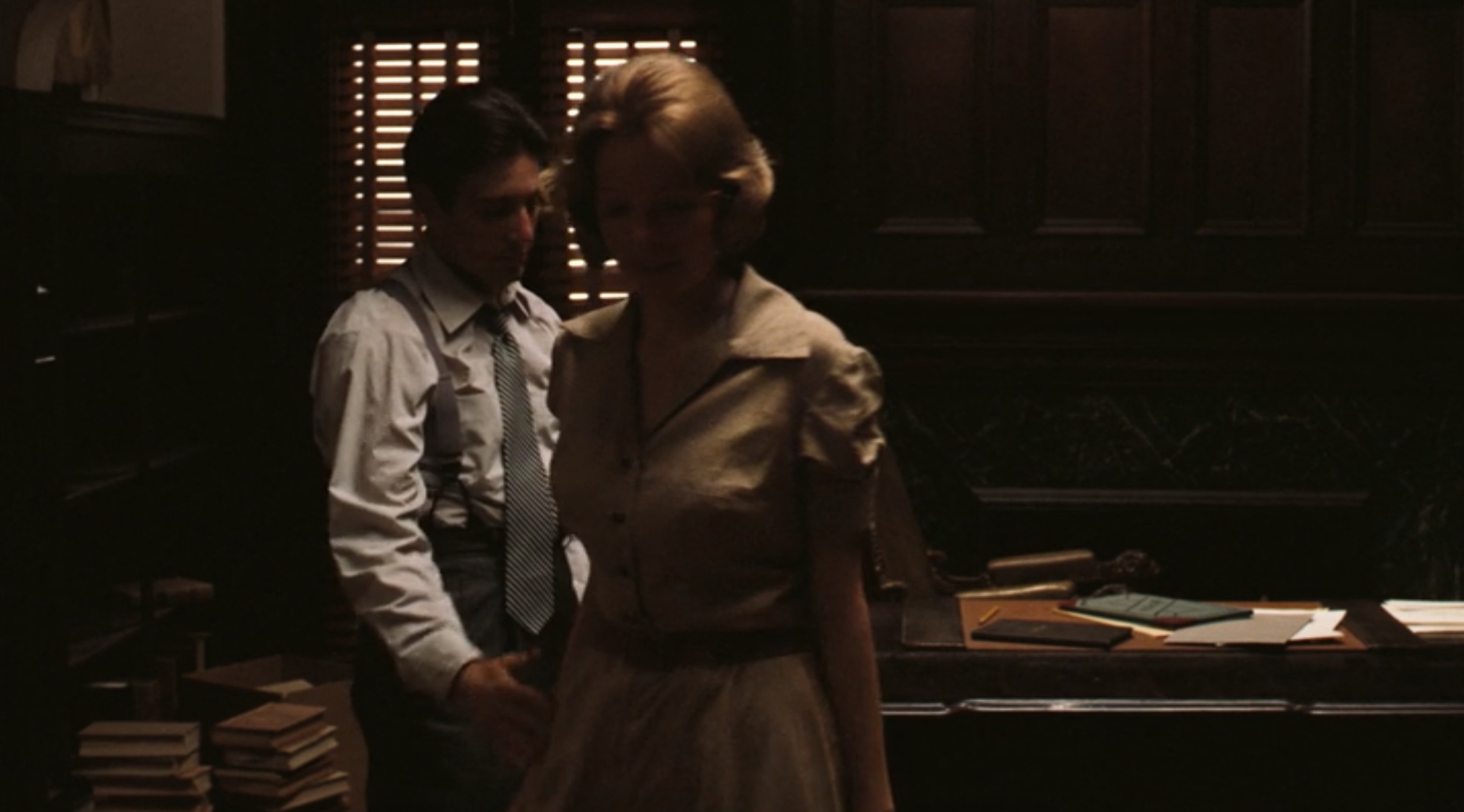
Vito’s room allows for little light and arrangement in furniture—all of which create an aesthetic appropriate to the idea of pre-WWII organized crime as a backdoor business. By contrast, Michael’s aesthetic reflects his attempt, in the postwar period, to push the family away from criminal activity and establish a completely legal organization. Both men long for the family business to become legitimate and believe that Michael can be the factor that allows for this clearing of the Corleone family name. However, the change of the interior design of an office is only a surface change. The end of the film—with Michael ordering the killing of his brother-in-law Carlo from a better-lit room—suggests that, in the world of The Godfather, appearances are deceiving indeed.
Robert Norte (Cal ’19) is an English major and a cinephile who enjoys unpacking the often-overlooked aspects of film.

